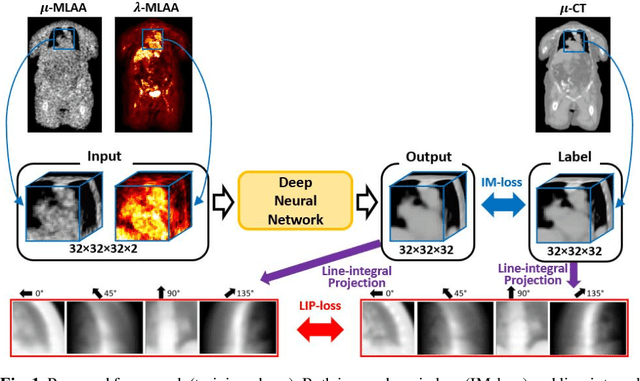Yihuan Lu
PET Head Motion Estimation Using Supervised Deep Learning with Attention
Oct 14, 2025Abstract:Head movement poses a significant challenge in brain positron emission tomography (PET) imaging, resulting in image artifacts and tracer uptake quantification inaccuracies. Effective head motion estimation and correction are crucial for precise quantitative image analysis and accurate diagnosis of neurological disorders. Hardware-based motion tracking (HMT) has limited applicability in real-world clinical practice. To overcome this limitation, we propose a deep-learning head motion correction approach with cross-attention (DL-HMC++) to predict rigid head motion from one-second 3D PET raw data. DL-HMC++ is trained in a supervised manner by leveraging existing dynamic PET scans with gold-standard motion measurements from external HMT. We evaluate DL-HMC++ on two PET scanners (HRRT and mCT) and four radiotracers (18F-FDG, 18F-FPEB, 11C-UCB-J, and 11C-LSN3172176) to demonstrate the effectiveness and generalization of the approach in large cohort PET studies. Quantitative and qualitative results demonstrate that DL-HMC++ consistently outperforms state-of-the-art data-driven motion estimation methods, producing motion-free images with clear delineation of brain structures and reduced motion artifacts that are indistinguishable from gold-standard HMT. Brain region of interest standard uptake value analysis exhibits average difference ratios between DL-HMC++ and gold-standard HMT to be 1.2 plus-minus 0.5% for HRRT and 0.5 plus-minus 0.2% for mCT. DL-HMC++ demonstrates the potential for data-driven PET head motion correction to remove the burden of HMT, making motion correction accessible to clinical populations beyond research settings. The code is available at https://github.com/maxxxxxxcai/DL-HMC-TMI.
Fast-MC-PET: A Novel Deep Learning-aided Motion Correction and Reconstruction Framework for Accelerated PET
Feb 14, 2023



Abstract:Patient motion during PET is inevitable. Its long acquisition time not only increases the motion and the associated artifacts but also the patient's discomfort, thus PET acceleration is desirable. However, accelerating PET acquisition will result in reconstructed images with low SNR, and the image quality will still be degraded by motion-induced artifacts. Most of the previous PET motion correction methods are motion type specific that require motion modeling, thus may fail when multiple types of motion present together. Also, those methods are customized for standard long acquisition and could not be directly applied to accelerated PET. To this end, modeling-free universal motion correction reconstruction for accelerated PET is still highly under-explored. In this work, we propose a novel deep learning-aided motion correction and reconstruction framework for accelerated PET, called Fast-MC-PET. Our framework consists of a universal motion correction (UMC) and a short-to-long acquisition reconstruction (SL-Reon) module. The UMC enables modeling-free motion correction by estimating quasi-continuous motion from ultra-short frame reconstructions and using this information for motion-compensated reconstruction. Then, the SL-Recon converts the accelerated UMC image with low counts to a high-quality image with high counts for our final reconstruction output. Our experimental results on human studies show that our Fast-MC-PET can enable 7-fold acceleration and use only 2 minutes acquisition to generate high-quality reconstruction images that outperform/match previous motion correction reconstruction methods using standard 15 minutes long acquisition data.
A Novel Loss Function Incorporating Imaging Acquisition Physics for PET Attenuation Map Generation using Deep Learning
Sep 03, 2019



Abstract:In PET/CT imaging, CT is used for PET attenuation correction (AC). Mismatch between CT and PET due to patient body motion results in AC artifacts. In addition, artifact caused by metal, beam-hardening and count-starving in CT itself also introduces inaccurate AC for PET. Maximum likelihood reconstruction of activity and attenuation (MLAA) was proposed to solve those issues by simultaneously reconstructing tracer activity ($\lambda$-MLAA) and attenuation map ($\mu$-MLAA) based on the PET raw data only. However, $\mu$-MLAA suffers from high noise and $\lambda$-MLAA suffers from large bias as compared to the reconstruction using the CT-based attenuation map ($\mu$-CT). Recently, a convolutional neural network (CNN) was applied to predict the CT attenuation map ($\mu$-CNN) from $\lambda$-MLAA and $\mu$-MLAA, in which an image-domain loss (IM-loss) function between the $\mu$-CNN and the ground truth $\mu$-CT was used. However, IM-loss does not directly measure the AC errors according to the PET attenuation physics, where the line-integral projection of the attenuation map ($\mu$) along the path of the two annihilation events, instead of the $\mu$ itself, is used for AC. Therefore, a network trained with the IM-loss may yield suboptimal performance in the $\mu$ generation. Here, we propose a novel line-integral projection loss (LIP-loss) function that incorporates the PET attenuation physics for $\mu$ generation. Eighty training and twenty testing datasets of whole-body 18F-FDG PET and paired ground truth $\mu$-CT were used. Quantitative evaluations showed that the model trained with the additional LIP-loss was able to significantly outperform the model trained solely based on the IM-loss function.
 Add to Chrome
Add to Chrome Add to Firefox
Add to Firefox Add to Edge
Add to Edge